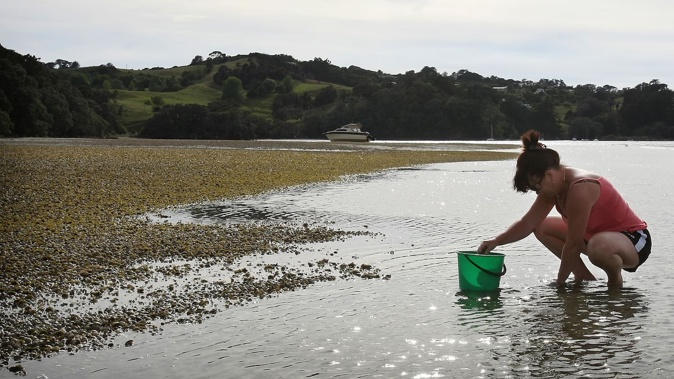
- Heatwaves are growing more frequent and intense in New Zealand’s estuaries, posing a threat to a plethora of species.
- In a new million-dollar study, scientists are seeking to understand what drives sudden, short-lived heat spikes that set off a cascade of damaging effects.
- The study is likely to focus on Auckland’s Whangateau Harbour, which was hit by a mass cockle die-off in 2009.
New Zealand’s estuaries are facing increasingly extreme heatwaves, scientists warn, posing a serious threat to crucial marine ecosystems and kaimoana.
Now, scientists have launched a million-dollar study to learn more about what drives sudden heat spikes that endanger a plethora of species living in these calm coastal enclaves.
Research suggests New Zealand’s marine heatwaves – like those under way around parts of coasts right now – are set to grow longer, stronger and more frequent under climate change.
Over recent years, scientists have observed mass die-offs among sea sponges and life-supporting kelp forests, along with feeding and breeding disruptions to animals like little blue penguins and our resident giant blue whales.
University of Auckland scientist Professor Karin Bryan said heatwaves in estuaries are similarly becoming more intense.
But little is known about the processes behind these rapid temperature surges, which can trigger catastrophic die-offs of shellfish and toxic algal blooms.
“When a whole bed of shellfish dies off, it’s obvious, and everyone has a theory about the causes,” said Bryan, from the university’s Centre for Climate, Biodiversity and Society – Ngā Ara Whetū.
Mudflats, she explained, absorb heat when the tide is out, and then “super-heated sediments can cook the water, so within a few short hours the temperature is intolerable for some species”.
New Zealand has around 350 estuaries, which serve as vital habitats for marine life and shorebirds, as well as important sources of kaimoana.
But when extreme temperatures hit, they set off a chain reaction of stressors: acidifying waters, depleting oxygen and increasing the toxicity of contaminants.
“The health of estuaries is important because they sequester carbon from the atmosphere, and mangroves protect the surrounding land against sea-level rise and coastal storms,” Bryan said.
Her team’s research will span the next three years, investigating how much of this heating is driven by tidal currents pulling in warm ocean water, atmospheric conditions, or other factors.
By analysing 20 years of satellite data, council coastal monitoring records and fresh field measurements, they hope to determine how often heatwaves occur and how fast estuarine temperatures are rising each year.
One of their key goals is to develop predictive tools that could be applied globally, helping scientists assess how rising temperatures might disrupt estuarine food chains and whether any mitigation efforts could help species cope.
“The temperature in estuaries is important because it adds to the many stressors on biodiversity,” Bryan said.
University of Auckland coastal scientist Professor Karin Bryan.
“We don’t know exactly why many of our coastal taonga species, like the hoiho – or yellow-eyed penguin – are declining.
“But most species are extremely sensitive to water temperature, so heating is adding to issues such as degraded habitat, disease, and poor food supply.”
To better understand the impact of estuarine heatwaves, the researchers will carry out three-week studies in two locations: likely Whangateau Harbour on Auckland’s east coast, where a mass cockle die-off occurred in 2009, and a west coast estuary with dark sediment, which absorbs more heat.
Using sensors and drones, they’ll map heat patterns and assess whether computer models can accurately predict temperature changes.
The team will also investigate whether rising water temperatures are linked to the expansion of seagrass beds around New Zealand’s coastline, or whether other factors, such as reduced predation or increased nutrients, are driving the trend.
Bryan noted estuarine vegetation can help cool the water, and local restoration efforts – such as planting trees around estuary margins – could buffer some of the impacts of climate change.
“Planting around an estuary won’t solve this complex problem, but if being involved in restoration projects helps convince people of the value of reducing their greenhouse gas emissions, that is a positive step.”
For Bryan, who grew up far from the ocean in Canada, living by the sea has underscored the urgency of protecting coastal environments.
“We have a huge coastline, so it should be at the top of the list of things we look after,” she said.
“In New Zealand, our estuaries are our food baskets, and they’re deeply engrained in our collective cultures and national psyche.”
Jamie Morton is a specialist in science and environmental reporting. He joined the Herald in 2011 and writes about everything from conservation and climate change to natural hazards and new technology.
Take your Radio, Podcasts and Music with you









